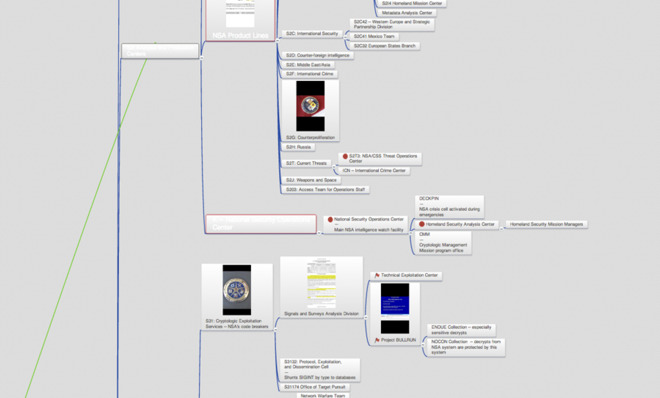Here is the NSA's unofficial org chart
I hope it's helpful


It's been a year since Edward Snowden first leaked his cache of documents to reporters. More than 1,500 pages of classified material about the National Security Agency's operations have been published, giving many of us a voyeuristic thrill and many others a very incomplete understanding of what the agency actually does. In a weird way, the public now knows a lot more about the NSA. What it thinks it knows about the NSA, however, doesn't exactly correspond with reality.
(Click here to see the full chart.)
That's one consequence of selectively releasing classified documents. It's also a result of a witches' brew of good journalism and bad journalism — with no neutral arbiter of what's right and what's not. As I've written before, the public is more engaged with issues of surveillance and privacy now, and that is good. The government is also on notice now about the limits of hubris and secrecy, and that is good, too.
The Week
Escape your echo chamber. Get the facts behind the news, plus analysis from multiple perspectives.

Sign up for The Week's Free Newsletters
From our morning news briefing to a weekly Good News Newsletter, get the best of The Week delivered directly to your inbox.
From our morning news briefing to a weekly Good News Newsletter, get the best of The Week delivered directly to your inbox.
As a way of contributing to that good, I've been trying to clarify how the NSA works and what it does. An org chart is the simplest way to keep track of such things. The NSA has a covert term for every database used, every processing system employed, every company partner, and every program. Snowden did not include an org chart, or a dictionary, so far as we know, so journalists and the public, and other interested parties, have often had to fill in the blanks with their own suppositions.
For the fourth time, I've extensively revised and updated my unofficial NSA org chart (which is too large to embed, so you'll have to click through). It includes a description and map of the NSA's Turbulence architecture, which is the system most extensively used to analyze and exploit converged network data, updates, and corrections to the list of databases; and a cleaner look at the Special Source Operations directorate, which manages the NSA's relationships with companies and their "accesses."
Refer to it when you're reading the next set of documents to leak. I hope it's helpful.
A free daily email with the biggest news stories of the day – and the best features from TheWeek.com
Marc Ambinder is TheWeek.com's editor-at-large. He is the author, with D.B. Grady, of The Command and Deep State: Inside the Government Secrecy Industry. Marc is also a contributing editor for The Atlantic and GQ. Formerly, he served as White House correspondent for National Journal, chief political consultant for CBS News, and politics editor at The Atlantic. Marc is a 2001 graduate of Harvard. He is married to Michael Park, a corporate strategy consultant, and lives in Los Angeles.
-
 The Salt Path Scandal: an ‘excellent’ documentary
The Salt Path Scandal: an ‘excellent’ documentaryThe Week Recommends Sky film dives back into the literary controversy and reveals a ‘wealth of new details’
-
 AI griefbots create a computerized afterlife
AI griefbots create a computerized afterlifeUnder the Radar Some say the machines help people mourn; others are skeptical
-
 Sudoku hard: December 17, 2025
Sudoku hard: December 17, 2025The daily hard sudoku puzzle from The Week
